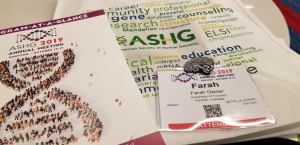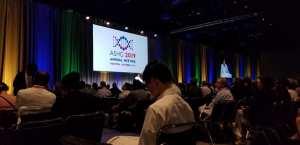 Earlier this month, over 8,900 individuals (including me!) headed to Houston to attend the 2019 American Society of Human Genetics’ (ASHG) Annual Meeting and learn more about cutting-edge research, science literacy and policy issues in the fields of genetics and genomics. While there were numerous findings presented at ASHG, I’ll highlight three of the more interesting issues (at least to me) – specifically poison exons, genetic exceptionalism, and DNA in the public sphere.
Earlier this month, over 8,900 individuals (including me!) headed to Houston to attend the 2019 American Society of Human Genetics’ (ASHG) Annual Meeting and learn more about cutting-edge research, science literacy and policy issues in the fields of genetics and genomics. While there were numerous findings presented at ASHG, I’ll highlight three of the more interesting issues (at least to me) – specifically poison exons, genetic exceptionalism, and DNA in the public sphere.
Poison exons: There were quite a few large-scale genome sequencing studies that caught my attention at ASHG, but my favourite session involved exploring poison exons in neurodevelopmental disorders. At this point, you may be wondering: what’s a poison exon – and why should we bother with them?
As Heather Mefford eloquently explained, we are currently in the era of sequencing – including gene panels, whole exome and genome sequencing – where de novo variants have been identified in a number of severe, sporadic conditions. New gene discoveries are being incorporated into clinics, yet we are still unable to uncover the genetic basis for almost ~25-50 percent of specific neurodevelopmental cases, such as epilepsies. Instead, the molecular answer may lie in genomic regions that remain under-explored, like non-coding variation, epigenetics, or variants in novel/alternative exons, such as poison exons.
Traditionally, genes include exons (coding regions) and non-coding introns, where introns are removed to produce a functional messenger RNA (mRNA) transcript. This mRNA transcript is later translated into a functioning protein, like keratin in our nails. But unlike regular exons, including a poison exon in an mRNA transcript will result in premature termination of proteins. These incomplete proteins are generally non-functional but, in some cases, including poison exons in transcripts can result in disorders such as Dravet syndrome. What complicates matters is that poison exons are not well annotated in the human reference genome, leaving poison exon identification to often be a difficult first step.
The remainder of the session explored how variants in poison exons can be identified to the tale of the development of a novel therapeutic. Some of the key takeaways here were:
- Poison exons are potential candidates that can explain the genetic basis behind some neurodevelopmental disorders.
- There is dynamic poison exon splicing in brain development, and we may need to systematically assay poison exons to enhance our understanding of diseases.
- Antisense oligonucleotides (ASOs) are a potential therapeutic to tackle poison exons in SCN1A One such ASO is heading to clinical trials in 2020.

There were over 8,000 researchers, journalists and staff attending the ASHG 2019 conference.
DNA in the public sphere: Today, genetic testing is being used to improve health outcomes, advance research and explore ancestry, but non-medical applications of genetic information can include death investigations, human trafficking, immigration and investigating crimes. In fact, in 2018, the arrest of the “Golden State Killer,” using genealogical websites, prompted fears that this could be a slippery slope, especially when it comes to genetic privacy.
To contemplate this broader issue, four panelists (CeCe Moore, Amy Lynn McGuire, Jennifer Wagner, Kate Spradley) discussed how genomic information is used and protected outside of research and medicine. In particular, two points stood out in this panel: the use of genetic genealogy in cold cases, and the statistics on where the public stands on genetic privacy.
Moore is a chief genetic genealogist at Parabon NanoLabs, where she is solving cold cases using genetic genealogy – and not through databases like AncestryDNA and 23AndMe. “My job is to identify the common ancestors […] who are sharing autosomal DNA,” says Moore, and emphasizes that her work is simply treated as one piece of evidence in a larger case. In some instances, her work is used to eliminate suspects.
But do people really care about their privacy as much these days given the increased sharing on social media and the growing use of wearables? McGuire highlighted that in a survey of 1310 people, a vast majority were concerned about the privacy of their health (68%) and online (69%) information, but that younger generations were significantly less likely to be concerned than older generations.
McGuire’s second survey, in 2018, asked people (n=1,587) whether law enforcement should be allowed to search social media accounts, cell phone records and genetic databases depending on the type of investigation. A majority (>89%) of respondents were comfortable with law enforcement using genealogical databases for cases involving missing persons, violence or children.
The same trend was seen for social media accounts and cell phone records, but fewer individuals (~50%) were comfortable with the idea of law enforcement utilizing such resources when it comes to non-violent cases. Key takeaway? McGuire says that “it’s all about trade-offs” and suggests that individuals often weigh the perceived risk and benefits of sharing genetic information in each scenario.
Genetic exceptionalism: Shifting gears to policy here, genetic exceptionalism refers to the idea that genetic information is so distinct from other realms of medicine that it must be treated differently from other types of medical data. ASHG president Leslie G. Biesecker strongly opposes this idea. In fact, Biesecker’s presidential address was titled An Unexceptional President, as he wanted to drive home the idea that genetic exceptionalism is a barrier to success, and instead creates obstacles between geneticists and other scientists, specialists and health care providers.
A later symposium on this very topic made the argument that genetic science and medicine is just medicine: it generates primary and secondary findings like any other medical subfield, such as imaging (MRIs) and routine laboratory panels. Interestingly, Theresa Marteau pointed out that there is no evidence that predictive tests, genetic or otherwise, play a discernible role in improving population health or reducing disparities in the context of well-studied behaviours, such as smoking and drinking. Despite this evidence, the idea of genetic exceptionalism continues to persist and has been embedded in history for a long time or, as Robert Resta put it, it is a “zombie concept that refuses to die.”
Instead, Kyle Brothers made the case that when everything in medicine is exceptional, nothing will be. Brothers suggested that we should follow the route of genetic contextualism: that each clinical context can share similarities and differences but, overall, they should reflect the same goals, values and principles of medicine.
And how will this shared meaning of goals, values and principles be worked out in different clinical contexts? There’s no shortcut here; practice and feedback will be key.
Latest posts by Farah Qaiser (see all)
- Scientists turned book authors: insights into the world of publishing - December 3, 2020
- First ever ComSciConGTA held virtually this fall - October 8, 2020
- Opportunities for professional growth in your science career in 2020 - January 16, 2020






Comments